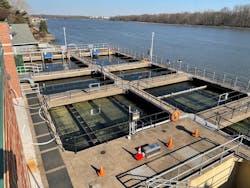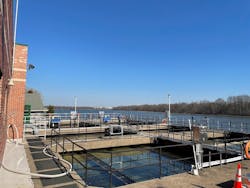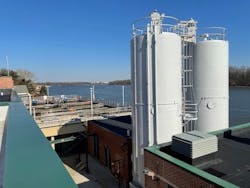Plant Profile: Aqua Pennsylvania Bristol Water Treatment Plant
Bob Crossen is senior managing editor for WWD. Crossen can be reached at [email protected].
|
Location: Bristol Township, Pennsylvania Size: 11 mgd rated capacity; 13 mgd peak waiver Equipment: rapid mixing, coagulation, floculation, chlorination, sediment, filtration, tank storage, disinfection |
Originally built with steam-driven turbine pumps in the 1870s, the Bristol Water Treatment Plant (WTP) in Pennsylvania is now a modern facility winning regional and national awards.
In May 2019, the facility won an award for the best tasting water in Pennsylvania, and in February 2021, the plant earned the Phase III Directors Award from the Partnership for Safe Water. This program was developed by the American Water Works Association (AWWA) and the U.S. EPA — and other partner organizations — to encourage utilities to strive toward continuous improvement.
While originally started in the 1800s, the facility was taken over by Bristol Borough in 1921. The Borough operated the plant until 1997, when Aqua America purchased the facility and transitioned it from a municipal authority to a private one.
Eric Damon, plant manager for Aqua Pennsylvania Bristol WTP, said the bigger challenge for the utility has been keeping the building standards up to code because of how old some of the structures are.
“We’ve made some serious necessary upgrades at the facility to bring us up to current codes and current times and current standards,” Damon said.
Despite the constraints the structures create for the utility, it still manages to keep its facility up to date with current treatment technology and digital systems to monitor and analyze water quality to a high degree.
The Water Through Bristol
The treatment plant serves a population of around 30,000 people — around 10,000 services connections — in Bristol Township; Croydon, Pennsylvania; and Edgely, Pennsylvania.
The facility starts by pumping water in from the Delaware River and sends it through flocculation and rapid mixing. It flows into sedimentation basis where chemical addition is incurred. Damon said chemical addition occurs at several stages of treatment based on the optimizations he and his team have discovered while achieving the Phase III Directors Award.
“Once we’re finished with the sedimentation, we move to filtration,” Damon said. “At post filtration, our water is pumped over to our storage tank facility where it receives its final treatment and is pumped out to the public.”
That storage tank facility amounts to a pair of 2 million gallon storage tanks of capacity. Damon said this amount of capacity helps buy time if any problems occur in the distribution system or if equipment needs to be shut down for repairs or other reasons.
The plant, he said, is permitted for 11 million gallons per day and has a waiver for capacity up to 13.5 mgd so long as the average flow is 11 mgd per day during that month. The amount of water leaving the plant is around 8 mgd.
In the search for deep optimization of processes and procedure, Damon said part of that process dealt with chemical doses and chemical choice.
“A lot of water treatment plants use to use pre-chlorine to chlorinate the water before sedimentation,” Damon said. “That, we found, creates a lot of disinfection by-products … so we use no pre-chlorine now, it’s all after sedimentation. And we’ve started using the chlorine dioxide as a pre-oxine. That has had a significant impact on our oxidation.”
He said the operators are always looking for ways to use more coagulant instead of polymers as it can save money. To do so, Damon and the facility team keeps a close eye on the facility’s parameters, such as raw water quality, total organic carbon and turbidity, among other data points.
Other areas of optimization were in filter performance and turbidity, much of which had been done through varied equipment choices and testing to determine what meets the needs of the plant.
Pride in Quality Work
Bristol WTP entered the Partnership for Safe Water in 2006 as part of a long-term goal to show the facility’s dedication to its craft. Since that time, the team at the plant has monitored and compiled data — including records prior to joining the partnership — to take an even harder look at what it could do better.
“This is really a culmination of some hardcore efforts that have taken place over the last 15 years,” Damon said. “[It’s] hard work and dedication to really improve our facilities and to optimize as best as we can.”
He said the experience of earning the award is a special time for him, his team and everyone at Aqua Pennsylvania. Positive recognition is rare for utilities. Receiving that recognition takes the whole team working to meet the guidelines of the partnership and hold each other to a high standard to get the award. Damon said the workers feel a lot of ownership for achieving it. Winning the Pennsylvania AWWA Chapter award in 2017 for taste only further proves that level of dedication.
“In the borough, they’re all served by the water they’re making so they take a lot of care in what they do,” Damon said. “They really do focus on making the best water that they can because they have to drink it too.”


